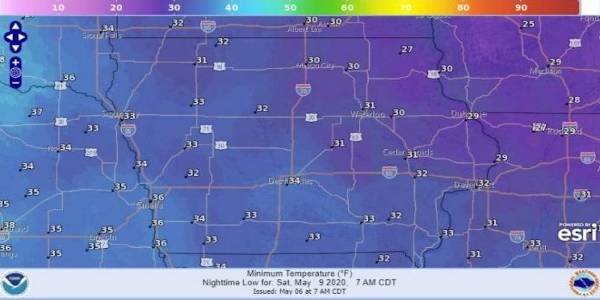By Mark Licht
Friday and Saturday night will have cold temperatures reach into northern Iowa and maybe even southern Iowa. Below is a National Weather Service low temperature prediction (https://digital.weather.gov) for Saturday, May 9. Notice that north of Interstate 80 has some risk potential for temperatures falling below freezing. Keep in mind is that dew point temperature are several degrees lower. I point this out because in low lying area or areas with no wind, air temperature could be slightly lower. One additional consideration is that warmer soils help buffer emerged seedlings by radiational warming of air just above the soil surface. If you really want to know what temperature emerged seedling are exposed to place a thermometer on at the soil surface and check it just before sunrise.

Temperature is the key for both corn and soybean. Temperature 28 oF or lower for a couple of hours will be lethal to growing tissue that has emerged. Temperatures between 28 oF and 32 oF will result in minimal frost injury to above ground tissue. And temperatures between 32 oF and 50 oF could result in poor vigor and growth. Regardless of temperatures, the next couple of days will put planted corn and soybean at greater risk for pathogen infection. Make sure to get out into your fields towards the middle to end of next week to assess stands. For frost injured crops, wait at least 3 days (maybe even 5-10 days if temperature is slow to rebound) following the last frost occurrence to be able to fully assess living versus damaged or injured tissue.
Yellow corn will quickly respond to the sunlight and increased temperatures. Frost injured, water-soaked corn likely won't grow, but if the growing point is still viable (cold temperature did not penetrate to the growing point) the plants will have to slough of the dead tissue. A dead growing point is unlikely unless temperatures get 28°F or lower for several hours.
Soybean cotyledons are resilient to cold temperatures. Expect some frost damage to cotyledons and hypocotyl around the margins but survival is likely unless there were several hours of temperatures below 30 oF. The apical meristem and/or auxiliary buds are not expected to be killed at temperatures down to 28 oF.
Regardless of emergence or not, patience will be the key. Assess stands after 3 to 5 days. If above ground vegetation is dead, look below ground to check for viable growing tissue.